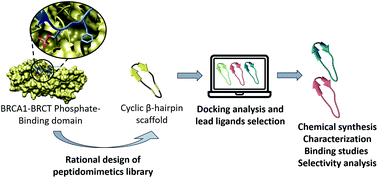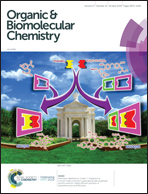β-Hairpins as peptidomimetics of human phosphoprotein-binding domains†
Abstract
Phosphoprotein-binding domains interact with cognate phosphorylated targets ruling several biological processes. The impairment of such interactions is often associated with disease development, namely cancer. The breast cancer susceptibility gene 1 (BRCA1) C-terminal (BRCT) domain is involved in the control of complex signaling networks of the DNA damage response. The capture and identification of BRCT-binding proteins and peptides may be used for the development of new diagnostic tools for diseases with abnormal phosphorylation profiles. Here we show that designed cyclic β-hairpin structures can be used as peptidomimetics of the BRCT domain, with high selectivity in binding to a target phosphorylated peptide. The amino acid residues and spatial constraints involved in the interaction between a phosphorylated peptide (GK14-P) and the BRCT domain were identified and crafted onto a 14-mer β-hairpin template in silico. Several cyclic peptides models were designed and their binding towards the target peptide and other phosphorylated peptides evaluated through virtual screening. Selected cyclic peptides were then synthesized, purified and characterized. The high affinity and selectivity of the lead cyclic peptide towards the target phosphopeptide was confirmed, and the possibility to capture it using affinity chromatography demonstrated. This work paves the way for the development of cyclic β-hairpin peptidomimetics as a novel class of affinity reagents for the highly selective identification and capture of target molecules.

- This article is part of the themed collection: Chemical Biology in OBC


 Please wait while we load your content...
Please wait while we load your content...